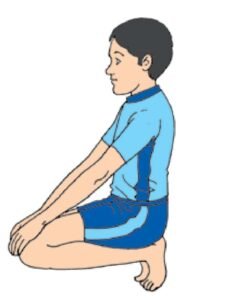What is Utkatasana ? – Steps, Poses and Benefits
What is Utkatasana ?
- In Sanskrit ut means ‘raised’ and kata refers to ‘hips’. This asana is also a balancing posture. The posture is known as utkatasana because in this asana, the hips are kept raised.
Let us perform the Utkatasana by following the steps given below:
- Starting position: Stand erect placing both the feet firmly on the floor.
1. Make a comfortable distance between the feet, about 8-12 inches.
2. Raise both the arms in front, up to shoulder level and palms should be facing downward.
3. Raising the heels stand on the toes and slowly sit on the toes.
4. Hands should be placed on the respective knees. Maintain the position for 5-10 seconds.
Releasing position:
5. Balancing the body, keep the arms on the floor.
6. Maintaining the balance, slowly stand erect on the toes and raise both the arms in front, up to shoulder level.
7. Place the heels on the floor. Bring the hands by the side of the thighs and feet together.
8. Stand erect with placing both the feet firmly on the floor.


Remember the following points:
| Do’s | Don’ts |
| • Maintain the balance while taking and releasing the posture. • In the final posture, upper part of the body should remain erect. • In the final posture, weight should be taken by hamstring muscles. |
• Do not put the body weight on heels. • Do not bend forward. |
Utkatasana Benefits :-
• It enhances the mobility of the knee joints, ankle joints and hip joints.
• It strengthens the muscles of the legs (hamstring and calf ), the arms, biceps, shoulder, the pelvis and the lower back.
• It reduces the fat in the waist and hip joint and makes good figure of the body. This helps in enhancing selfesteem.
• It improves functioning of digestive system.
Utkatasana Limitations :-
• Those having complaints of reeling sensation should not practise it.
• Avoid performing the asana if knee joints and ankle joints are having pain and stiffness.
Yoga Latest Post :- Click Here
TOP YOGA MCQs Questions and Answers
1. Which is the Sanskrit root (verb form) for the etymological derivation of the word “Yoga”?
(A) Yug
(B) Yuge
(C) Yuj
(D) Yuje
Click to show/hide
2. Who was the Yoga Guru of Swami Kuvalayananda?
(A) Pattabhi Jois
(B) T. Krishnamacharya
(C) Madhav Das
(D) Yogendra
Click to show/hide
3. Which of the following practice leads to immortality, according to Ishavasyopanishad?
(A) Vairagya
(B) Viveka
(C) Vidya
(D) Vishaya
Click to show/hide
4. Definition of Yoga according to Kathopanishad is
(A) Control on mind
(B) Control on sense organs, mind and intellect
(C) Control on sense organs and intellect
(D) Control on body and mind
Click to show/hide
5. How many types of Kundalini by nature are described in Siddha Siddhant Paddhati?
(A) 02
(B) 03
(C) 04
(D) 06
Click to show/hide
6. Which Upanishad described the ‘Shandilya Vidya’?
(A) Kathopanishad
(B) Brihadaranyakopanishad
(C) Aitareyopanishad
(D) Chhandogyopanishad
Click to show/hide
7. Which of the following are the types of Pranayama, according to Patanjala Yoga Sutra?
I. Stambhavritti Pranayama
II. Sahita Pranayama
III. Bahyabhyantara Vishayakshepi Pranayana
IV. Kevali Pranayama
Use the codes given below for correct answer:
(A) I and II are correct.
(B) II and III are correct.
(C) I and III are correct.
(D) II and IV are correct.
Click to show/hide
8. Given below are two statements, labelled as Assertion (A), and a Reason (R). Indicate your answer from the alternatives below:
Assertion (A): Pashchimōttanasana is contraindicated in sciatica.
Reason (R): Pashchimōttanasana is a type of forward bending asana.
All types of forward bending asanas should be contraindicated in sciatica. In the context of above two statements, which one of the following is correct?
(A) Both (A) and (R) are true and (R) is the correct explanation of (A).
(B) Both (A) and (R) are true, but (R) is not the correct explanation of (A).
(C) (A) is true, but (R) is false.
(D) (A) is false, but (R) is true.
Click to show/hide
9. In which of the following text ‘Bhujangikaran’ Pranayama is described?
(A) Yoga Vashishtha
(B) Shiva Samhita
(C) Hatha Ratnavali
(D) Siddha Siddhanta Paddhati
Click to show/hide
10. What do you understand by the term ‘Adhi’?
(A) Physical disorders originated in Annamaya Kosha.
(B) Mental/Emotional disorders originated in Manomaya Kosha.
(C) Mental/Emotional disorders originated in Annamaya Kosha.
(D) Physical disorders originated in Manomaya Kosha.
Click to show/hide
11. Which day is celebrated as ‘International Day of Yoga’?
(A) June 20
(B) June 21
(C) June 22
(D) June 23
Answer ⇒ ????
